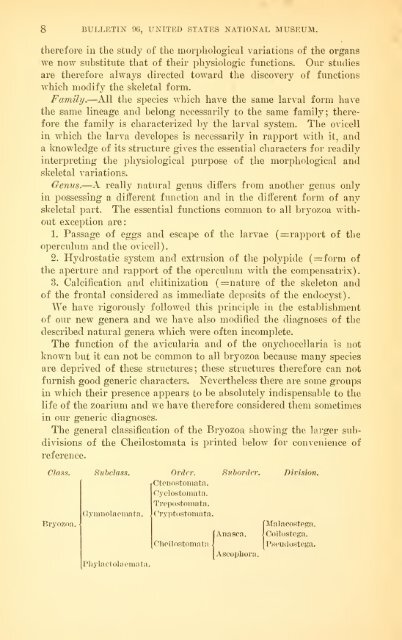Bulletin - United States National Museum - Smithsonian Institution
Bulletin - United States National Museum - Smithsonian Institution
Bulletin - United States National Museum - Smithsonian Institution
You also want an ePaper? Increase the reach of your titles
YUMPU automatically turns print PDFs into web optimized ePapers that Google loves.
8 BULLETIN 9C, UNITED STATES NATIONAL MUSEUM.<br />
therefore in the study of the morphological variations of the organs<br />
we now substitute that of their physiologic functions. Our studies<br />
are therefore always directed toward the discovery of functions<br />
which modify the skeletal form.<br />
Family.—All the species which have the same larval form have<br />
the same lineage and belong necessarily to the same family; there-<br />
fore the family is characterized by the larval system. The ovicell<br />
in which the larva developes is necessarily in rapport with it, and<br />
a Ivnowledge of its structure gives the essential characters for readily<br />
interpreting the j)hysiological purpose of the morphological and<br />
skeletal variations.<br />
Genus.—A really natural genus differs from another genus only<br />
in possessing a different function and in the different form of any<br />
skeletal part. The essential functions common to all bryozoa with-<br />
out exception are:<br />
1. Passage of eggs and escape of the larvae (=rapport of the<br />
operculum and the ovicell).<br />
2. Hydrostatic system and extrusion of the polypide (=:form of<br />
the aperture and rapport of the operculum with the compensatrix).<br />
3. Calcification and chitinization (=nature of the skeleton and<br />
of the frontal considered as immediate deposits of the endocyst).<br />
We have rigorously followed this principle in the establishment<br />
of our new genera and we have also modified the diagnoses of the<br />
described natural genera which were often incomplete.<br />
The function of the avicularia and of the onychocellaria is not<br />
known but it can not be common to all bryozoa because many species<br />
are deprived of these structures; these structures therefore can not<br />
furnish good generic characters. Nevertheless there are some groups<br />
in which their presence appears to be absolutely indispensable to the<br />
life of the zoarium and we have therefore considered them sometimes<br />
in our generic diagnoses.<br />
The general classification of the Bryozoa showing the larger sub-<br />
divisions of the Cheilostomata is printed below for convenience of<br />
reference.<br />
Class. Subclass. Order. Suborder. Division.<br />
fCtenostomata.<br />
Cyclostoinata.<br />
Trepostomata.<br />
Gymnolaomata. J Cryptostoinata.<br />
Bryozoa. [Malaco.stejra.<br />
(Anasca. J Coilostega.<br />
Phylactolaeruata.<br />
Ascopliora.<br />
[Pseiulostef^a.

















